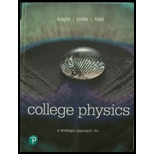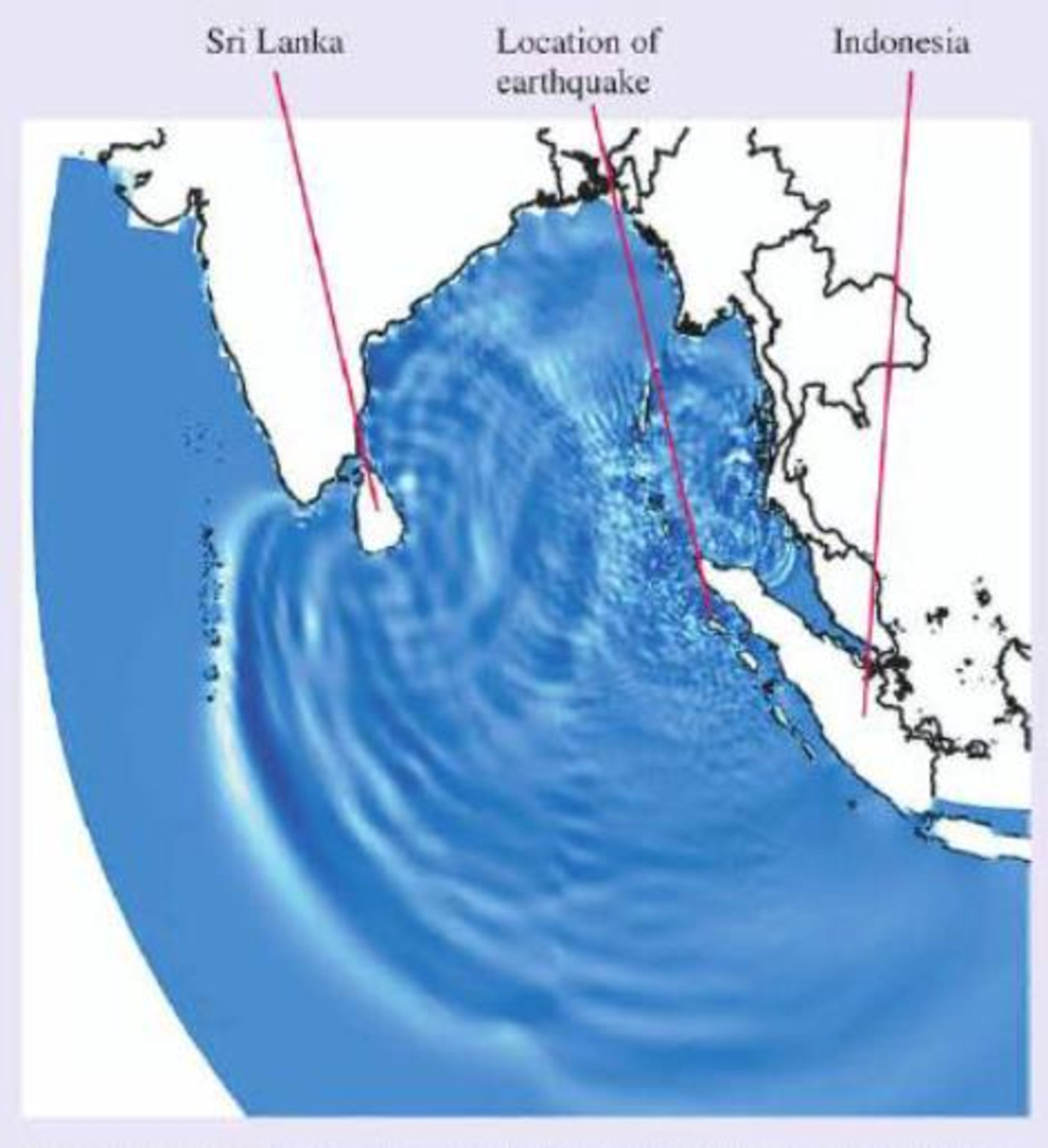
Concept explainers
Waves in the Earth and the Ocean
In December 2004, a large earthquake off the coast of Indonesia produced a devastating water wave, called a tsunami, that caused tremendous destruction thousands of miles away from the earthquake's epicenter. The tsunami was a dramatic illustration of the energy carried by waves.
It was also a call to action. Many of the communities hardest hit by the tsunami were struck hours after the waves were generated, long after seismic waves from the earthquake that passed through the earth had been detected al distant recording stations, long after the possibility of a tsunami was first discussed. With better detection and more accurate models of how a tsunami is formed and how a tsunami propagates, the affected communities could have received advance warning. The study of physics may seem an abstract undertaking with few practical applications, but on this day a better scientific understanding of these waves could have averted tragedy.
Let’s use our knowledge of waves to explore the properties of a tsunami. In Chapter 15, we saw that a vigorous shake of one end of a rope causes a pulse to travel

One frame from a computer simulation of the Indian Ocean tsunami three hours after the earthquake that produced it. The disturbance propagating outward from the earthquake is clearly seen, as are wave reflections from the island of Sri Lanka.
along it, carrying energy as it goes. The earthquake that produced the Indian Ocean tsunami of 2004 caused a sudden upward displacement of the seafloor that produced a corresponding rise in the surface of the ocean. This was the disturbance that produced the tsunami, very much like a quick shake on the end of a rope. The resulting wave propagated through the ocean, as we see in the figure.
This simulation of the tsunami looks much like the ripples that spread when you drop a pebble into a pond. But there is a big difference—the scale. The fact that you can see the individual waves on this diagram that spans 5000 km is quite revealing. To show up so clearly, the individual wave pulses must be very wide—up to hundreds of kilometers from front to back.
A tsunami is actually a “shallow water wave,” even in the deep ocean, because the depth of the ocean is much less than the width of the wave. Consequently, a tsunami travels differently than normal ocean waves. In Chapter 15 we learned that wave speeds are fixed by the properties of the medium. That is true for normal ocean waves, but the great width of the wave causes a tsunami to “feel the bottom.” Its wave speed is determined by the depth of the ocean: The greater the depth, the greater the speed. In the deep ocean, a tsunami travels at hundreds of kilometers per hour, much faster than a typical ocean wave. Near shore, as the ocean depth decreases, so docs the speed of the wave.
The height of the tsunami in the open ocean was about half a meter. Why should such a small wave—one that ships didn't even notice as it passed—be so fearsome? Again, it's the width of the wave that matters. Because a tsunami is the wave motion of a considerable mass of water, great energy is involved. As the front of a tsunami wave nears shore, its speed decreases, and the back of the wave moves faster than the front. Consequently, the width decreases. The water begins to pile up, and the wave dramatically increases in height.
The Indian Ocean tsunami had a height of up to 15 m when it reached shore, with a width of up to several kilometers. This tremendous mass of water was still moving at high speed, giving it a great deal of energy. A tsunami reaching the shore isn’t like a typical wave that breaks and crashes. It is a kilometers-wide wall of water that moves onto the shore and just keeps on coming. In many places, the water reached 2 km inland.
The impact of the Indian Ocean tsunami was devastating, but it was the first tsunami for which scientists were able to use satellites and ocean sensors to make planet-wide measurements. An analysis of the data has helped us better understand the physics of these ocean waves. We won’t be able to stop future tsunamis, but with a better knowledge of how they are formed and how they travel, we will be better able to warn people to get out of their way.
The following questions are related to the passage“Waves in the Earth and the Ocean ” on the previous page.
Rank from fastest to slowest the following waves according to their speed of propagation:
A. An earthquake wave
B. A tsunami
C. A sound wave in air
D. A light wave
Want to see the full answer?
Check out a sample textbook solution
Chapter P Solutions
College Physics: A Strategic Approach (4th Edition)
Additional Science Textbook Solutions
University Physics Volume 2
University Physics (14th Edition)
Physics for Scientists and Engineers with Modern Physics
Physics for Scientists and Engineers: A Strategic Approach, Vol. 1 (Chs 1-21) (4th Edition)
Introduction to Electrodynamics
- The ocean floor in underlain by a layer of basalt that constitutes the crust, or uppermost layer, of the Earth in that region. Below this crust is found denser periodotite rock that forms the Earths mantle. The boundary between these two layers is called the Mohorovicic discontinuity (Moho for short). If an explosive charge is set off at the surface of the basalt, it generates a seismic wave that is reflected back out at the Moho. If the speed of this wave in basalt is 6.50 km/s and the two-way travel time is 1.85 s, what is the thickness of this oceanic crust?arrow_forward(a) Seismographs measure the arrival times of earthquakes with a precision of 0.100 s. To get the distance to the epicenter of the quake, they compare the arrival times of S and Pwaves, which travel at different speeds. Figure 16.48) If S and Pwaves travel at 4.00 and 7.20km/s, respectively, in the region considered, how precisely can the distance to the source of the earthquake be determined? (b) Seismic waves from underground detonations of nuclear bombs can be used to locate the test site and detect violations of test bans. Discuss whether your answer to (a) implies a serious limit to such detection. (Note also that the uncertainty is greater if there is an uncertainty in the propagation speeds of the S and P—waves.) Figure 16.48 A seismograph as described in above problem. (credit: Oleg Alexandrov)arrow_forwardAstronomy Application Energy from the Sun arrives at the top of the Earth’s atmosphere with an intensity of 1.30kW/m2. How long does it take for 1.8109J to arrive on an area of 1.00 m2?arrow_forward
- A sonar echo returns to a submarine 1.20 s after being emitted. What is the distance to the object creating the echo? (Assume that the submarine is in me ocean. not in fresh water.)arrow_forwardWaves on a swimming pool propagate at 0.75 m/s. You splash the water at one end of the pool and observe the wave go to the opposite end, reflect, and return in 30.00 s. How far away is the other end of the pool?arrow_forwardScouts at a camp shake the rope bridge may have just crossed and observe the wave crests to be 8.00 m apart. If they shake it the bridge twice per second, what is the propagation speed of the waves?arrow_forward
- The Bay of Fundy, Nova Scotia, has the highest tides in the world. Assume in midocean and at the mouth of the bay the Moons gravity gradient and the Earths rotation make the water surface oscillate with an amplitude of a few centimeters and a period of 12 h 24 min. At the head of the bay, the amplitude is several meters. Assume the bay has a length of 210 km and a uniform depth of 36.1 m. The speed of long-wavelength water waves is given by v=gd, where d is the waters depth. Argue for or against the proposition that the tide is magnified by standing-wave resonance.arrow_forwardAs you pass freight truck with a trailer on a highway, you notice mat its trailer is bouncing up and down slowly. Is it more likely that the trailer is heavily loaded or nearly empty? Explain your answer.arrow_forwardLater in this book, you will learn that sound is a wave. The wavelength and frequency f of a wave are related by f = v where v is the speed of the wave. Musicians refer to these different wavelengths or frequencies by their notes (AG). Use the information in the following table to plot the frequency on the vertical axis and 1/ on the horizontal axis. Give a conceptual Interpretation and numerical value of the slope on your graph.arrow_forward
- How many times a minute does a boat bob up and down an ocean waves that have a wavelength of 40.0 m and a propagation speed of 5.00m/s ?arrow_forwardCircular water waves decrease in amplitude as they move away from where a rock is dropped. Explain why.arrow_forwardWhy are soldiers in general ordered to “route step" (walk out of step) across a bridge?arrow_forward
 College PhysicsPhysicsISBN:9781938168000Author:Paul Peter Urone, Roger HinrichsPublisher:OpenStax College
College PhysicsPhysicsISBN:9781938168000Author:Paul Peter Urone, Roger HinrichsPublisher:OpenStax College Physics for Scientists and Engineers with Modern ...PhysicsISBN:9781337553292Author:Raymond A. Serway, John W. JewettPublisher:Cengage Learning
Physics for Scientists and Engineers with Modern ...PhysicsISBN:9781337553292Author:Raymond A. Serway, John W. JewettPublisher:Cengage Learning Physics for Scientists and EngineersPhysicsISBN:9781337553278Author:Raymond A. Serway, John W. JewettPublisher:Cengage Learning
Physics for Scientists and EngineersPhysicsISBN:9781337553278Author:Raymond A. Serway, John W. JewettPublisher:Cengage Learning Physics for Scientists and Engineers: Foundations...PhysicsISBN:9781133939146Author:Katz, Debora M.Publisher:Cengage Learning
Physics for Scientists and Engineers: Foundations...PhysicsISBN:9781133939146Author:Katz, Debora M.Publisher:Cengage Learning Principles of Physics: A Calculus-Based TextPhysicsISBN:9781133104261Author:Raymond A. Serway, John W. JewettPublisher:Cengage Learning
Principles of Physics: A Calculus-Based TextPhysicsISBN:9781133104261Author:Raymond A. Serway, John W. JewettPublisher:Cengage Learning Physics for Scientists and Engineers, Technology ...PhysicsISBN:9781305116399Author:Raymond A. Serway, John W. JewettPublisher:Cengage Learning
Physics for Scientists and Engineers, Technology ...PhysicsISBN:9781305116399Author:Raymond A. Serway, John W. JewettPublisher:Cengage Learning





